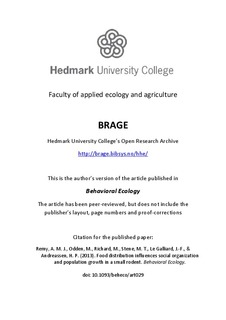Food distribution influences social organization and population growth in a small rodent
Rémy, Alice; Odden, Morten; Richard, Murielle; Stene, Marius Tyr; Le Galliard, Jean-François; Andreassen, Harry Peter
Journal article, Peer reviewed
Permanent lenke
http://hdl.handle.net/11250/134482Utgivelsesdato
2013Metadata
Vis full innførselSamlinger
Originalversjon
Remy, A. M. J., Odden, M., Richard, M., Stene, M. T., Le Galliard, J.-F., & Andreassen, H. P. (2013). Food distribution influences social organization and population growth in a small rodent. Behavioral Ecology. doi: 10.1093/beheco/art029 10.1093/beheco/art029Sammendrag
In polygynous mammals, the spatial clumping and predictability of food should influence spacing behavior of females whose reproductive success depends to a great extent on food availability, which would in turn affect male spacing behavior. Changes in the social and mating systems can then influence individual fitness and population dynamics. To test these hypotheses, we manipulated food distribution and predictability in enclosed populations of bank voles (Myodes glareolus) and monitored spacing behavior, survival, and reproduction of adult females and males over 3 months. Food was either spread out (dispersed treatment), spatially clumped and highly predictable (clumped treatment) or spatially clumped but less predictable (variable treatment). We found that females in the clumped treatment were more aggregated and had more overlapping home ranges compared with females in the dispersed and variable treatments. Male spacing behavior followed the same patterns. Despite different social organizations between treatments, no differences in home range size and mating systems were found in females and males. In addition, we found that females in the clumped food treatment had a higher probability of successfully producing weaned offspring, likely due to lower infanticide rates. This led to higher population growth compared with the other 2 treatments. These results suggest a tight relationship between the spatiotemporal distribution of food, social organization, and population dynamics.
Beskrivelse
This is the postprint version of the article. The published article can be located at the publisher's website
